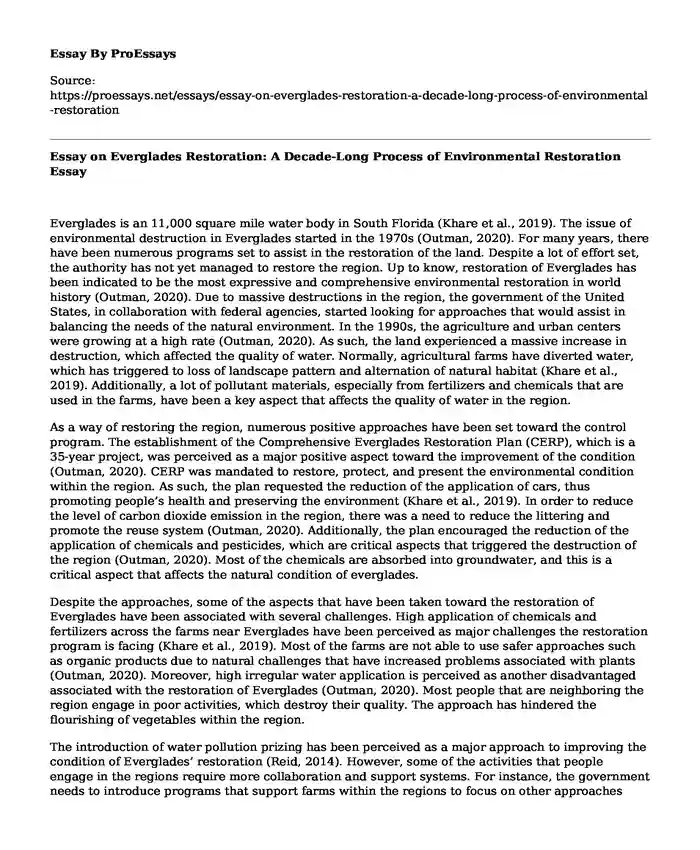Everglades is an 11,000 square mile water body in South Florida (Khare et al., 2019). The issue of environmental destruction in Everglades started in the 1970s (Outman, 2020). For many years, there have been numerous programs set to assist in the restoration of the land. Despite a lot of effort set, the authority has not yet managed to restore the region. Up to know, restoration of Everglades has been indicated to be the most expressive and comprehensive environmental restoration in world history (Outman, 2020). Due to massive destructions in the region, the government of the United States, in collaboration with federal agencies, started looking for approaches that would assist in balancing the needs of the natural environment. In the 1990s, the agriculture and urban centers were growing at a high rate (Outman, 2020). As such, the land experienced a massive increase in destruction, which affected the quality of water. Normally, agricultural farms have diverted water, which has triggered to loss of landscape pattern and alternation of natural habitat (Khare et al., 2019). Additionally, a lot of pollutant materials, especially from fertilizers and chemicals that are used in the farms, have been a key aspect that affects the quality of water in the region.
As a way of restoring the region, numerous positive approaches have been set toward the control program. The establishment of the Comprehensive Everglades Restoration Plan (CERP), which is a 35-year project, was perceived as a major positive aspect toward the improvement of the condition (Outman, 2020). CERP was mandated to restore, protect, and present the environmental condition within the region. As such, the plan requested the reduction of the application of cars, thus promoting people’s health and preserving the environment (Khare et al., 2019). In order to reduce the level of carbon dioxide emission in the region, there was a need to reduce the littering and promote the reuse system (Outman, 2020). Additionally, the plan encouraged the reduction of the application of chemicals and pesticides, which are critical aspects that triggered the destruction of the region (Outman, 2020). Most of the chemicals are absorbed into groundwater, and this is a critical aspect that affects the natural condition of everglades.
Despite the approaches, some of the aspects that have been taken toward the restoration of Everglades have been associated with several challenges. High application of chemicals and fertilizers across the farms near Everglades have been perceived as major challenges the restoration program is facing (Khare et al., 2019). Most of the farms are not able to use safer approaches such as organic products due to natural challenges that have increased problems associated with plants (Outman, 2020). Moreover, high irregular water application is perceived as another disadvantaged associated with the restoration of Everglades (Outman, 2020). Most people that are neighboring the region engage in poor activities, which destroy their quality. The approach has hindered the flourishing of vegetables within the region.
The introduction of water pollution prizing has been perceived as a major approach to improving the condition of Everglades’ restoration (Reid, 2014). However, some of the activities that people engage in the regions require more collaboration and support systems. For instance, the government needs to introduce programs that support farms within the regions to focus on other approaches such as organic farming to reduce the application of fertilizer and chemicals. Therefore, the application of water pollution prizing may not have a major impact on the restoration of Everglades.
References
Khare, Y., Naja, G. M., Stainback, G. A., Martinez, C. J., Paudel, R., & Van Lent, T. (2019). A phased assessment of restoration alternatives to achieve phosphorus water quality targets for Lake Okeechobee, Florida, USA. Water, 11(2), 327. https://www.mdpi.com/2073-4441/11/2/327/pdf
Outman, C. J. (2020). Florida’s red tide: The hidden costs of land development in the Everglades. Fordham https://research.library.fordham.edu/cgi/viewcontent.cgi?article=1099&context=environ_2015
Reid, A. (2014). Everglades Foundation offers $10 million water pollution cleanup prize. Sun Sentinel. http://articles.sun-sentinel.com/2014-09-22/news/fl-everglades-pollution-prize-20140922_1_everglades-foundation-ceo-phosphorus-cleanup-eric-eikenberg
Cite this page
Essay on Everglades Restoration: A Decade-Long Process of Environmental Restoration. (2023, Nov 04). Retrieved from https://proessays.net/essays/essay-on-everglades-restoration-a-decade-long-process-of-environmental-restoration
If you are the original author of this essay and no longer wish to have it published on the ProEssays website, please click below to request its removal:
- Social, Economic, and Environmental Injustices Essay
- The Benefits of Converting to Renewable Energy and Away from Fossil Fuels
- Research Paper on Heavy Metals: Causes of Global Environmental Pollution
- Essay Example on Floods in Indonesia: Devastation, Power Outage and More in 2020
- Exploring the National Park: A Memorable Adventure - Essay Sample
- Paper Example on Red Bag Waste: A Healthcare Hazard to Handle Safely
- Essay Example: Non-Renewable Resource Depletion & Sustainable Development Models







